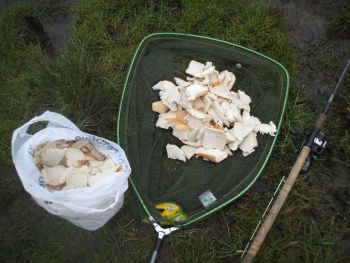{‘How to fish with bread’ is a topic that regularly comes up in the Anglers’ Net Fishing Forums. We are indebted to forum member ‘Anderoo’ for providing this article, which explains the process in simple terms. Fishing with bread is effective for a number of freshwater fish. Also, not only is it cheap, but the availability of bread also means that you can go fishing at any time. No need to wait for the bait shop to open! – Ed}
Bread is a greatly under-used and extremely effective bait (not to mention cheap and readily available), but one which many people can find frustrating. ‘Mashed bread’ can end up looking like doughy porridge that sticks to your hand when you try to lob it into the river, and anglers often sit racked with doubt about whether their flake hookbait is still on the hook or not. All in all, it can easily be given up as a bad job and other baits used instead.
This is a shame, as fishing a flake hookbait over mashed bread groundbait is a fantastic way to catch specimen chub and roach from the winter rivers.
Making Mashed Bread
The vital part of this is making sure your bread is dry enough to make proper mash. If it is too fresh, you will end up with the sticky porridge that’s no good for anything. Two or three days before your session, buy a couple of cheap sliced white loaves, tear the slices up into rough pieces, and hang them up in the shed in a landing net or two (out of the way of any hungry mice) and allow them to go a bit stale. When they are just right for making into mash, they will feel dry but not hard. If you tried to use it on the hook, it would be too dry to stay on.
When you get to the water, the first thing to do after allowing your bread to get nice and dry, is get it soaking wet! Put as much bread bits as you think you’ll need in a landing net and submerge it in the water until the air bubbles stop.


Next, bring it back on the bank and using both hands, grab handfuls of the wet bread and squeeze out as much water as you can, putting the bread balls in a bag ready for mashing.


Then, using your hands, mash it all up until there are no big pieces left, turning it all over now and again to make sure it’s an even consistency. The finished mash should not be too sticky, and you should be able to squeeze it into balls and throw it like conventional groundbait.


It is quite heavy, so once in the water, it will sink quite quickly, releasing little bits of bread as it goes. On the bottom, it will break down quickly and in rivers, release a really attractive bready, milky cloud downstream, drawing fish up to your baited spot. The amount you put in will depend on things like what fish you’re aiming to catch and how good the conditions are. That’s a whole other topic!
Using flake hookbaits
The main cause of bread falling off the hook is that it simply isn’t fresh enough. Whereas you want dry, stale bread for the perfect bread mash, bread for the hook has to be really fresh and doughy and full of moisture. A good quality fresh white sliced loaf will be plenty for a day’s fishing.
Take a piece of flake from a slice of bread. Below is a size 6 hook and the size of flake I would use with it, fishing for chub. For smaller hooks just use a smaller piece of bread.

Fold the piece of flake over, and pinch it hard at the fold, creating a firm, doughy bit, and hook the firm part through once.

Finally, fold the piece of flake again, this time the other way, away from the hook point, and squeeze hard again where the shank of the hook is.

This leaves a large, fluffy hook bait held really firmly on the hook, with the point well exposed for easy hooking. With bread hooked like this, you can be completely confident it is always firmly on the hook, just waiting to be picked up by a whopping great chub or roach – in fact, it’s usual to find it still on the hook after reeling in against the current.

So – dry bread for mash, fresh bread for flake. Good luck, and enjoy!
Anderoo
© Andrew Walker, 2011




















